Focus Shifts from Sleep to True Circadian Health
Any solution claiming to reset circadian rhythms must have the TIMING of light at its center. This will become a central pillar of wellness: from circadian lighting to circadian diets to apps that use timed light doses to crush jet lag.
By Beth McGroarty
A $432 BILLION SLEEP MARKET AND WE’RE STILL NOT SLEEPING
We’re at the strangest place culturally when it comes to sleep. We’ve never been so obsessed: We buy smartwatches and Oura rings to track our sleep quality relentlessly every night; we pony up for the latest, greatest, smartest mattress; we gobble sleep tonics, CBD (and yes, Ambien and Xanax) and “sleep ice cream”; we pay to crawl into nap pods; and we travel far just to bed down at sleep retreats. The wellness world and Silicon Valley have unleashed every device and solution seemingly imaginable, from sleep robots that cuddle us and control our breathing[1] to pricey sleep supplement subscription plans. We have made complex sleep shrines of our (now often desexualized) bedrooms, banishing our partners through “sleep divorces.” This has created an entire “sleep economy” set to reach $585 billion by 2024[2].
Sleep has suddenly become such an over-the-top wellness trend that the media has begun mocking our agonizing over it, noting the rise of orthosomnia[3], a condition where anxiety over sleep tracking causes sleep problems. When, in human history, have we ached so much for sleep and unconsciousness? Why, with an avalanche of sleep solutions and a newly sleep-obsessed culture, do we remain in a sleepless epidemic, with around one in three of us sleeping badly and one in 10 having regular insomnia?
The reason is that most of these generic sleep solutions, and our modern lives, defy the basic facts of circadian biology. Humans evolved to be highly sensitive to the 24-hour solar cycle and super-regular exposure to natural light and dark. Nearly all organisms, including humans, have internal daily clocks (circadian rhythms) that control almost every biological system in our bodies, from our sleep-wake cycles and mood and performance patterns to our metabolic, immune and reproductive systems. The bedrock of circadian science is that exposure to regular light-dark cycles provides the daily “time cues” needed to reset our circadian clocks every single day, and not only determines how well we sleep but our very cellular health. We need the sun’s bright blue light in the day to be alert and active, and we need dark to kick-start our brain’s sleep mode and recovery.
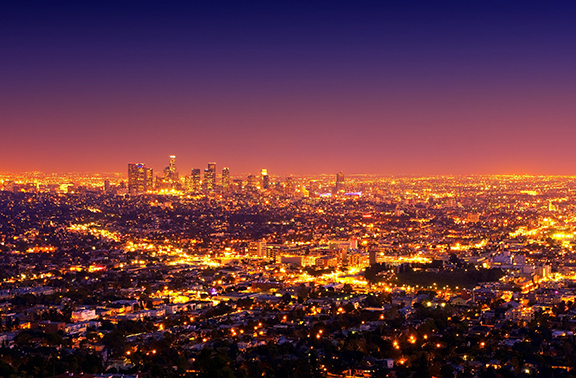
Humans today, however, have never been exposed to so much disruption to their circadian rhythms, such as the glaring disconnect between natural solar time and our social “clocks.” We’re taking in light and dark in historically whacked-out, unnatural ways. We blast our eyes after dusk with blue-enriched light from ever-brighter, addictive screens, tricking our brains into thinking it’s still daytime: Netflix binging, checking social media until we pass out. Work increasingly doesn’t conform to solar time. While 20 percent of people are nightshift workers, reversing their day-night behavior, gig work is also soaring: Fifty percent of the world’s workforce works remotely at least half the week[4], part of the creeping “always-on” work culture that encourages us to further disconnect from natural cycles. We have a shrinking global world: more airline travel so more circadian disruptions such as jet lag and global conference calls at all hours of the night. Ours is a 24/7 culture (from gyms to supermarkets); light pollution increasingly floods our skies at night; and we’re tied to desks, deprived of natural sunlight in the day. Never before have human environments been such a “lightmare[5].”
As Dr. Steven Lockley, associate professor of medicine at Harvard and one of the world’s top experts on circadian rhythms and sleep, puts it: “The absolute key to healthy sleep and circadian rhythms is stable, regularly-timed daily light and dark exposure—our natural daily time cues. Sleep negates light input to the brain, and so keeping a regular sleep pattern will also help maintain regular light-dark exposure. After dusk, when natural light disappears, we must minimize the negative impact of man-made light. In the day, we have evolved to be in the light, ideally sunlight, but if not, high-quality blue-enriched indoor light. Period. Given that most of our body systems express circadian rhythms, ensuring proper alignment of our internal circadian clocks, starting with the management of lighting, will have major impacts on human health.”
While we’ve been obsessed with sleep, and trying to get more of it with smart pillows and tonics, it’s the timing of sleep that is absolutely key to getting high-quality, restorative sleep. This means sleeping at the right circadian time, and the only solutions that can actually reset circadian rhythms have LIGHT at the center of them.
So, we predict a major shift in wellness: less focus on all the generic sleep solutions and a keen new focus on circadian health optimization for not only sleep but for all the brain and body systems that are controlled by the circadian clock. It means that the TIMING of biology will become something we need to measure and manage, and light will be a central part of any solution.
This trend—from a “sleep” to a “circadian rhythm optimization focus”—takes various forms:
- More people will finally bring circadian rhythm-supporting lighting (and behaviors) into their homes, with an explosion of tunable, biodynamic lighting solutions that sync light with the time of day.
- New technologies such as the Timeshifter app offer personalized jet lag plans with timed light exposure advice as the foundation to help travelers eliminate jet lag, and could have important applications for “timeshifting” shift workers to new work schedules, or even preparing patients for surgeries and treatments to improve efficacy.
- More hotels, wellness resorts and airlines will think beyond generic sleep offerings to offer true circadian solutions for travelers based on their circadian cycle, revolving around the timing of light.
- While intermittent fasting is all the rage, people don’t realize that this is also usually a circadian-based solution: It’s natural for diurnal animals such as humans to eat during daylight when we evolved to digest food. More people will adopt the terminology and practice of “circadian eating”: eating when it’s light, stopping after dark.
Dr. Lockley predicts: “Circadian health optimization—incorporating the type and timing of light—will become more important than ‘sleep’ in health and wellness within the next few years. Medical and technological solutions that will help us realign our internal circadian clocks with each other, and our internal clocks with the outside world, will surge.”
Mickey Beyer-Clausen’s keynote at the Global Wellness Summit (GWS), on how timing light exposure can eliminate jet lag, inspired this wider trend.
CIRCADIAN BIOLOGY
Key facts
The circadian clock in sophisticated life forms (such as mammals) is one extraordinary system. The body’s master clock-controller lives in nerve cells in the brain’s hypothalamus called the suprachiasmatic nucleus, and it’s tuned to the day-night signal by light coming through the eyes and optic nerve. This timekeeping overlord in the brain then orchestrates a network of peripheral clocks that exist in nearly every organ throughout the body (yes, your liver and ovaries have their own clocks), turning on and off a host of clock genes and a wave of timekeeping proteins that rise and fall in a curve in nearly every cell in your body every 24 hours—just like the sun. It’s a magnificent, light-timed cellular choreography that runs on a tight daily cycle and controls almost every body function.
In 2017, a group of researchers won the Nobel Prize in Medicine[6] for discovering how clock genes control our daily rhythms. One of the many circadian genes is the period gene that makes a protein called PER that, in concert with other proteins, builds up at night and degrades during the day in a continuous feedback loop. This controls not just when we sleep but also our heart rate and blood pressure, the immune system, metabolism, body temperature, hormones and even mood. This breakthrough research showed how fundamental the circadian system is in synchronizing our daily biorhythms with the 24-hour rotation of the planet—and how we’re ruled by an inner clock that adapts our body processes to different times of the day with exquisite precision. These clocks are in our DNA.
Disruptions to our circadian rhythms, from those ever-increasing mismatches between our internal clock and lifestyle, when we override our natural cycles, have significant health consequences, including a higher risk of obesity, diabetes, some cancers, heart disease, depression, gut disorders, allergies, infections, premature aging—and early death. There have been more than 650 studies connecting light to health.
Research also increasingly shows[7] how people are chronobiologically hardwired with genes that make us night owls or early birds—called our chronotype. Early risers’ daily peak performance occurs early during the day, while natural night owls’ occurs later. Researchers estimate about 40 percent of people are morning or evening types, and 60 percent are in-between. Our chronotype impacts circadian cycles: Early birds have a faster internal clock, for example, as short as a 23.5-hour cycle, whereas night owls have a slower clock, taking up to 25 hours to complete one cycle. These internal clocks need to be reset, just like a watch, exactly 24 hours each and every day, and the light-dark cycle is the synchronizer.
CIRCADIAN & SLEEP MISCONCEPTIONS
Dr. Lockley points out some key misconceptions and misusages of the word/ concept “circadian” that can plague sleep and wellness markets—in an era where frustrating “circadian washing” is on the rise.
“Sleep” is not the same as circadian rhythms: Sleep is an output of the circadian clock in combination with another control system, the sleep homeostat, which measures how long we have been awake or asleep. Many other things affect sleep, so measuring sleep is not the same as measuring the clock, and the differences can be enormous. Circadian rhythms are much wider and more complex than sleep, as they impact and orchestrate all of our organs, our brain, and cellular activity.
The circadian clock anticipates environmental time—it does not reflect it or have anything to do with the “social” time of day. The clock anticipates the timed physiology that will happen tomorrow, when we wake/ sleep, eat, etc., to ensure that we do these things at the right time. To be a real circadian rhythm, it must be generated from within.
Just because something is rhythmic, it’s not necessarily circadian: Rhythms that are not generated from within are, by definition, not circadian rhythms. They may have a rhythm peaking in the day (diurnal) or night (nocturnal) but may be generated by an external influence such as physical activity, eating or sleeping. Growth hormone (GH) is a good example. GH is not a circadian rhythm but is a sleep-dependent one: It’s only released during deep sleep, which usually happens at night, and while it, therefore, looks circadian, it isn’t, as the rhythm would go away without sleep occurring and is therefore not internally generated.
As an anticipator, the biological clock thrives on stability: stable, day-in-and-day-out light and dark cues; regular sleep-wake times; regular lifestyles (exercise, eating).
Light governs human circadian biology: circadian rhythms cannot be meaningfully reset by exercise, stress-reduction, yoga, massage, food, sound baths, etc.
CIRCADIAN TRAVEL
Jet lag solved…and shift from generic sleep solutions in travel to those personalized to travelers’ circadian realities
The travel industry—hotels, wellness resorts and airlines—have recently gone all-in on sleep. We have the hotel mattress wars, a profusion of sleep-focused wellness retreats, and sleep scientists designing entire resort sleep programs. Destinations are throwing every kind of amenity and program at their guests’ exhaustion: elaborate pillow menus; sleep aromatherapy and massages; guided meditation; oxygen therapy; cryotherapy; special sleep workouts; and minibars and menus filled with sleep tonics, CBD and “sleep bites.” Travel companies are increasingly using “circadian” language around this avalanche of sleep products/ services, claiming they “reset circadian rhythms,” with the media even predicting “circadian travel”[8] as a 2020 travel trend because of the rise of sleep-focused travel everything.
The problem is these generic sleep solutions, and this huge travel industry focus on sleep and fatigue, while supportive of general wellbeing, are not “circadian.” They have no impact on our circadian rhythms and are helpless in fighting what ails so many travelers: jet lag.
Jet lag is caused when our 24-hour sleep/ wake, light/dark cycle shifts too suddenly (as we hurtle across time zones) for our circadian rhythms to catch up. It’s a massive travel problem, with huge costs to human health and happiness: In 2018, 448 million passengers traveled on long-haul flights. When asked, 93 percent of them said they struggled with jet lag[9]. Everyone knows the disastrous impact on our mood, sleep and digestion, with frequent travelers suffering the same increase in diseases that shift workers experience: more strokes, diabetes and cancers. The old way people dealt with jet lag was entirely wrong: sleep as much as you can on the flight, take meds such as Ambien (which don’t shift circadian rhythms), trust in the airplane’s Dreamliner lighting systems, maybe have that on-arrival jet lag massage. Jet lag is so debilitating that we arrive a day early to catch up and opt for business class and five-star hotels in desperation.
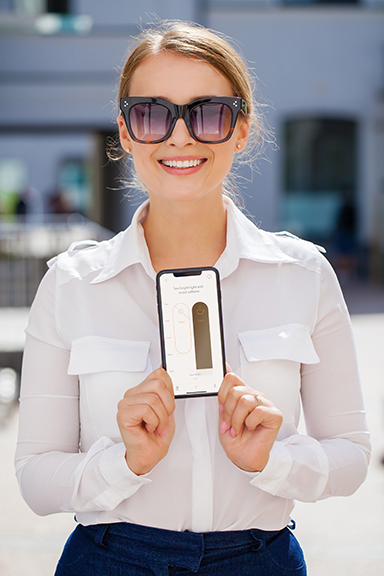
The timing of light exposure—not sleep, exercise, food or caffeine—is key to eliminating jet lag and can be the difference between a successful trip or a miserable one. The right light exposure at the right time can significantly accelerate travelers’ adaptation to new time zones. Seeing light at the wrong time makes jet lag much worse. Finally, the jet lag nightmare is over thanks to Timeshifter, which helps travelers adapt to new time zones fast by focusing on precisely timed light exposure. It’s an app that was literally developed with rocket scientists, as well as with Dr. Lockley, who has worked for more than a decade applying circadian science to NASA astronauts to alleviate their profound jet lag and improve sleep and alertness.
Timeshifter is blissfully simple: You input your sleep pattern (whether you’re an early bird, night owl or neither), whether you’re open to using a melatonin supplement and/ or caffeine and your itinerary. And presto, you get a crystal-clear schedule of when you need to prioritize bright light and when you need to avoid light, when you should take (small amounts of) melatonin and caffeine and when you should sleep/ nap and for how long. It works like magic. It’s easy to control exposure to light (by donning sunglasses in the airport), or see as much light as possible during a flight (watching a movie on a brightly lit screen is enough) when everyone else is trying to sleep. Beyer-Clausen notes that while you may get funny looks from people now, in a couple of years, we will see travelers everywhere in the midst of all kinds of “timeshifting.”
Other research centers are developing technology to tackle jet lag: Rensselaer Polytechnic Institute just announced[10] it has developed a wearable device that analyzes a person’s biometric info and can then recommend the right sleep and light schedule to re-optimize circadian rhythms. The clinical gold standard in measuring a person’s circadian rhythm state is blood or saliva tests identifying melatonin and cortisol levels, hardly an instant reading. But the researchers used algorithms that process data such as heart rate and body temperature, collected by the wearable, to convert to a circadian rhythm measurement. They say their bio-sensing tech that can tell you where you are in the circadian phase works in-line with clinical hormone measurements, and it would be a whole new approach to jet lag. (It’s being funded by the US Department of Defense.)
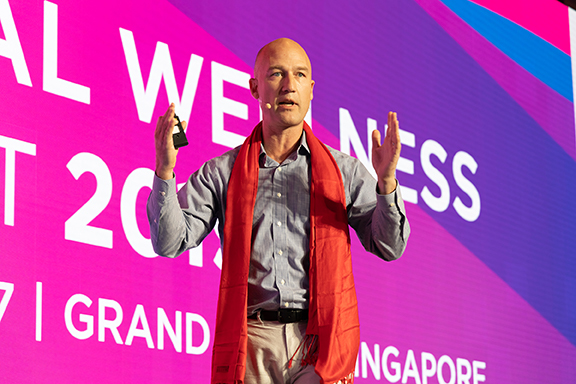
Timeshifter is both a shining example and a metaphor for a new trend in travel: more hotels, wellness resorts and airlines expanding beyond generic sleep offerings to offer true circadian, light-centric solutions for individual travelers based on their circadian cycles.
Because Timeshifter is the first app to combine rigorous scientific research with an intuitive interface, it makes it a go-to solution for airlines, hotels and resorts; travel agencies; and businesses with traveling employees looking to tackle jet lag. So far, they’ve announced partnerships with wellness travel leader Six Senses Hotels Resorts Spas, United Airlines, Montblanc, CWT (formerly Carlson Wagonlit Travel) and have signed up several Fortune 500 clients.
We will see more circadian “light moves” at destinations. Germany’s Lanserhof Tegernsee has launched a new sleep program that has a medical analysis called Chronotherapie, which works on the sleep-wake rhythm; light therapy and blue-light filter glasses for guests at night; high-tech FreshBeds and smart sleepwear that optimize sleep temperature; and a kill-switch in rooms that shuts off all Wi-Fi, light and electrosmog. New York City’s new Equinox Hotel is all about sleep and has sleep coaches who analyze a guest’s circadian rhythm state. IHG is piloting circadian lighting in rooms from Healthe by Lighting Science (more below), using its GoodDay and GoodNight spectrum light technologies. Note: For the time zone-jumping traveler, these would need to be paired with an app such as Timeshifter to personalize the right light at the right time.
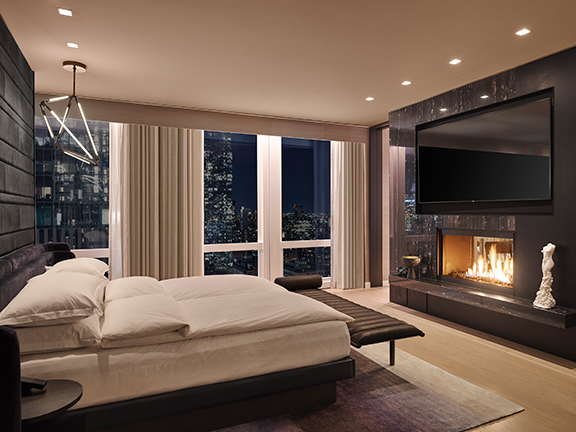
At the GWS, Beyer-Clausen predicted some ways that the travel industry will fight jet lag. He expects that flight-booking sites will add a new “less jet lag” filter in addition to the existing “cheapest” and “fastest” flight searches. In-flight entertainment systems will tell us when to nap, see and avoid light and eat, based on travelers’ itineraries. Personalized jet lag-adapted circadian light will rise in airplane seats and in hotel rooms. Airport lounges will have jet lag-reduction areas with light/dark zones/therapy. We would add that hotels and wellness resorts that partnered with a Timeshifter-ish app could precisely customize lighting in rooms and food schedules for their time zone-crossing guests.
We don’t expect the hotel pillow wars or sleep massages to disappear, and they’re relaxing and wonderful to have. But we expect that circadian science will inform travel experiences in crucial new ways. There will be new clarity about how some of the things now being done in the name of “sleep health” actually make things worse for travelers, for example, exercise or acupuncture at the wrong time, and new clarity about what actually synchronizes circadian clocks: LIGHT and DARK. (Again, not special “sleep” foods, workouts or massages.)
When you think about it, some of the biggest current travel trends seem to be travelers unconsciously seeking circadian health and getting back to their natural rhythms. Slow travel (walking tours, train travel, etc.) is sustainability-focused but also rejects the circadian disruptions of changing time zones fast. The camping/glamping mania, which means rising with the sun and winding down at dark, is a powerful circadian re-calibrator.
CIRCADIAN LIGHTING
Get your home light right…finally
Most of us have read about circadian lighting for years: the new lighting technologies that are tunable, biodynamic and sync with the time of day. You would think with all the talk that most of us would have it. We think 2020 will be the year that the light bulb goes off: More people will finally bring circadian lighting and behaviors into their homes. Some of the change will be no-tech: adopting regimes where you disconnect from devices/TV and dim lights well before bed—banishing iPads/phones from the room. We will naturally learn over time that sleep means avoiding light—and the time to disconnect from our devices well before sleep is NOW.
More people will make a simple switch in their home lighting: using bright, short wavelength, blue-light bulbs in the day and switching to dimmer, warmer, longer wavelength bulbs with red, yellow and orange color spectrums (think: campfire) at dusk—which boosts melatonin. And more people will go highest-tech: with app-, Bluetooth- and Wi-Fi-controlled LED tunable lights in their homes that automatically adjust day and night light color temperature and brightness levels.
Circadian lighting was a $400 million market in 2017, expected to jump to $4 billion by 2024[11], because we now have the technology, and more people will use it. People spend so much on their wellness; they need to spend a few more bucks on their bulbs.
There’s an explosion of circadian lighting solutions hitting the market. Healthe, developed with NASA scientists, has a wireless control device that uses GPS to track the positions of its “SunTrac” lightbulbs with the aim of simulating the natural arc of the sun throughout the day, transitioning from daytime blue light for productivity to mimicking light that promotes the brain’s natural response to sunset. The straightforward Soraa Healthy Lightbulb emits dimmable “Zero Blue” light. Dyson’s new Lightcycle lights adapt brightness and color based on time of day, owner’s routine and even age. Savant just launched an app-based home lighting system that is all about flexibility: You can set different light schedules for different rooms (i.e., you need a brighter kitchen, and the kids are on a different schedule)—or just press the button, and it switches rooms to the natural setting, based on astronomical time and your location.
Sleep masks that bring customized light therapy right to your face, serving up dimmer, red light at night when you’re trying to fall asleep and blue light to wake you up, such as Sound Oasis or Illumi, are taking off—with Dreamlight’s model also letting you set the mask’s temperature. Blue light-blocking glasses are going mainstream: Warby Parker just launched its own line.
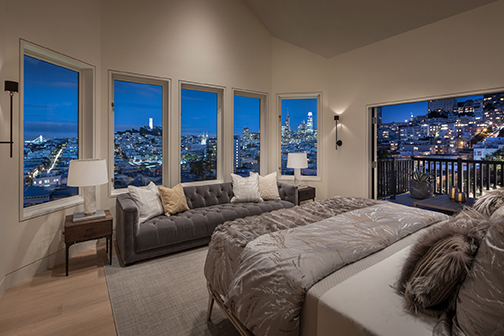
In the wellness home/real estate wars, “lux” (the measurement unit for light) is the new luxe, with circadian lighting (and every possible sleep design solution imaginable) becoming a key selling point. Delos’ new “home wellness intelligence system” Darwin features a circadian lighting system that lights up the home with cool tones in the morning and warm ones in the evening—and it’s completely automatic. San Francisco-based Troon Pacific’s “ultra-performance homes”[12] deploy every design weapon imaginable to support sleep and natural light cycles: from automated motorized shades to advanced day-to-night lighting systems and even no light-reflecting, shiny surfaces anywhere.
In this newly enlightened age, neuroscientists, doctors and architects are all working hard on nailing the science of circadian rhythm-supporting light: what intensity and color, at what time and for how long. And for whom, because circadian systems differ from person to person: by age, where you live, etc. For instance, when kids hit puberty, they have their circadian and sleep cycles pushed about two hours later than a typical adult, and while human evolution began near the equator, where daylight hours are consistent, most of us live with ever-shortening and lengthening days, becoming more extreme as we head up or down toward the poles.
There are debates among scientists, and certainly among lighting companies (seeking market differentiators), about what the right light at the right time truly is. Scientists will argue that we focus so much on over-lighting our eyes (hence brains) at night that we forget how critical the issue of our under-lit, desk-bound day lives are for our circadian health—and that any great lighting design needs to tackle both. Many of the new lighting systems aim to replicate natural light as it would subtly shift throughout the day. While this is unlikely to do any harm, Dr. Lockley argues that these subtle changes are not needed and not detected by the brain for control of circadian rhythms and alertness. We need bright blue-enriched days and dark nights, with as dim and red-enriched light as possible from dusk to bedtime. He argues nuanced “dawn to dusk” lighting changes throughout the day are unnecessary. And with the rise of all these light therapies and masks, we need to remember that blasting sunlight-simulating light when we’re exhausted to perk up or red “sleep” light when we’re desperate for shut-eye, if not timed correctly, could further whack out an already whacked out circadian system. Circadian rhythms, we cannot repeat enough, are internal systems, not external quick fixes like a pill. They thrive with regular light-dark cycles, day after day after day.
THERMAL WELLNESS
Not a circadian agent, but a supporter
We all know we should sleep in cool environments, and new solutions to aid us are rising. A key aspect of human circadian rhythms is that after dark, our bodies undergo changes to help transition us into sleep. One big change is that brain and body temperatures drop, and warm bedrooms counteract this. As a recent article in the Atlantic[13] explains, temperature plays a critical role in supporting sleep: We need to be able to lose heat to sleep and being too hot or too cold interferes with this process. Studies show[14] that people with sleep disorders sleep longer—and are more alert in the morning—in 61˚F rather than 75˚F rooms, and people who sleep in hot environments[15] have elevated stress hormones in the morning. Medical experts agree we should sleep in environments somewhere between 60–67˚F.
Climate change makes for more hot nights, air conditioning your bedroom to 60˚F can waste energy and regulating your temperature can be difficult to do. New smart mattresses/pads are here to help: For instance, R&D teams spent over 2.6 million hours in Tempur Sealy’s Thermal Lab to create the Tempur-breeze mattress. To dissipate heat and humidity, its materials are engineered at the molecular level to combine pressure-relieving, motion-isolating properties with open-cell foam so it feels up to eight degrees cooler all night long. With the Ooler mattress pad, filled with tubes that bring heated or cooled water to the surface, you can set your bed to that optimal temperature, or you can use the app to schedule temperature changes over the night—a cool bed for sleep and a warmer bed to wake up to. Eight Sleep, a new “sleep fitness company,” offers a smart mattress that dynamically warms or cools your bed based on your body temperature, while Sleep Number just unveiled its “Climate 360” smart bed, which analyzes the body’s sleep cycles and automatically adjusts the bed’s temperature.
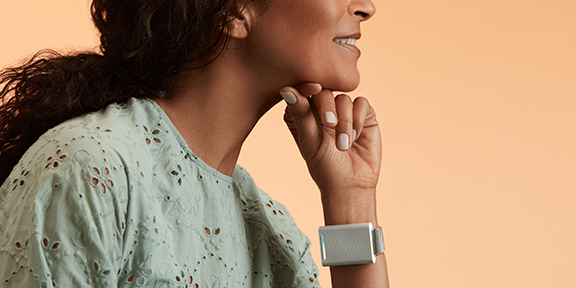
“Thermal wellness” solutions, all based on impacting body temperature for greater wellbeing, is a rising wellness trend in general. For instance, Embr Wave is a watch-like device that sits on your wrist, a sensitive area packed with thermoreceptors, and with a press of the button, it changes how hot or cold you feel (not your actual body temperature)—and it features a thermo-sleep mode. Sleep temperature technology, from apps to smart mattresses, will continue to rise. But while temperature has a daily rhythm, it’s only circadian when generated internally. As Dr. Lockley notes: “The sidewalk does not have an internal clock but will show a strong 24-hour rhythm in temperature. Obviously, the sidewalk heats up and cools down based on external factors, not, as in humans, due to an internal clock. External temperature therapies do not shift circadian rhythms, but they can support our body’s sleep mode directly.
THE CIRCADIAN DIET
“Light” eating
For decades, diets have been all about what we eat (we’ve scurried from the Mediterranean to the keto diet, etc.)—but the science is mounting fast that when we eat has profound metabolic and weight loss consequences. This new evidence is reflected in the rise of intermittent fasting (Google’s most-searched diet of 2019), which typically restricts eating and drinking to an eight-10-hour window a day.
A host of studies now indicate that alternating between periods of daily eating and fasting has eye-opening effects, with researchers hypothesizing that it conforms to the age-old way that humans ate: We experienced periods of food scarcity leading to “metabolic switching.” The evidence for intermittent fasting seems powerful.
A recent Johns Hopkins meta-review of studies16 found that it lowers blood pressure, lipid levels and heart rate. A new Salk Institute study[17] shows the implications for the diabetes and obesity epidemic: People with metabolic syndrome who limited food/ beverage consumption to a 10-hour window for three months saw big improvements in body composition and cholesterol levels. Research from the University of Texas Southwestern Medical Center found that mice that ate a normal amount of calories— but in restricted hours—lived 15 percent longer; if that applies to humans, that would mean increasing longevity from 80 to 92. Intermittent fasting’s association with everything from weight loss to forestalling diabetes is putting chrono-nutrition (timed food intake) front-and-center in wellness.
But is it the “intermittency” of eating or the fact that the fasting is circadian-synced that is the lynchpin? Because light and dark are the twin gods of our circadian clocks, and humans evolved to digest food in the day—what’s the metabolic (and sleep) impact of eating after dark, which jolts the brain into thinking that it’s daytime? How does matching the timing of eating with our circadian rhythms (with light and dark) impact health? More studies suggest that we should be embracing—and adopting the terminology of—a CIRCADIAN diet.
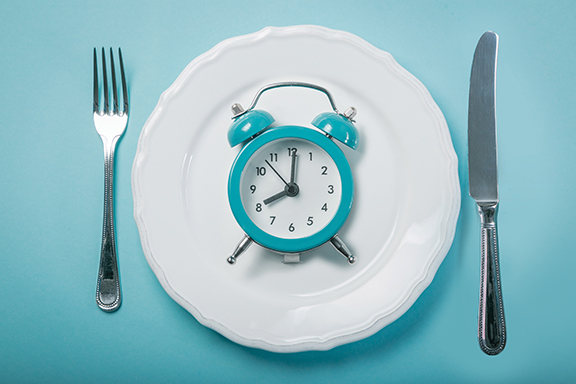
While intermittent fasting can have people taking their first bite (an important cue that impacts other clocks in our organs) way after the light of morning (say, 1–2 p.m.), a body of evidence shows that calories are metabolized better in the morning than evening: Researchers from Harvard University and the University of Murcia, Spain, found that early eaters[18] lose 25 percent more weight (and faster) than late eaters. Hebrew University studies show that synchronizing mealtimes with our circadian rhythms leads to significantly more weight loss and reduced insulin resistance than if you ate the same food (of any kind) without a schedule, concluding that a larger breakfast, a medium-sized lunch and small dinner drive optimal results.
The way that the timing of our eating communicates timing info to all the cells in our body is an extremely complex science. A 2019 study[19] showed how insulin resets circadian clocks by increasing the synthesis of period proteins (controlled by the “clock genes”) and how the exposure to light (and its cortisol production) needs to precede the insulin/feeding timing to get the highest amplitude in clock gene rhythm—or optimal circadian rhythms. And scientists are discovering how the circadian clock directly affects the microbiome (our gut has its own circadian clock): Washington University researchers just discovered[20] an immune cell that sets the clock for the gut, suggesting why circadian rhythm disruptions (those late nights, shift work) are linked to gastrointestinal problems and everything from obesity to colon cancer.
We’re seeing the research on intermittent fasting roll in, but we will see more studies evaluating whether all intermittent fasting is indeed created equal. We need more studies on the impact of timing meals to the light-dark cycle (circadian-synced eating and fasting), and how that impacts insulin levels and fat-burning hormones.
We predict more people will experiment with timing their eating and intermittent fasting differently: eating when it’s light, stopping when it’s dark. The potential of “clock nutrition” on weight loss and metabolic health—and research unriddling the complex interplay of light, our circadian clocks and our microbiota—is an exciting development and just revving up.
THE FUTURE
So much research is underway in the emerging field of circadian medicine. Scientists are developing molecules that target proteins that could repair and supercharge our cells’ clock functions, with a new class of circadian drugs that could chemically reset our circadian systems and prevent some of the worst diseases: obesity, diabetes, Alzheimer’s—and even slow aging way down. See the excellent overview in Wired[21] of how the new circadian medicines on the horizon could save lives.
Apps such as Timeshifter, which use timed light exposure to help travelers eliminate jet lag, could certainly be extended to help shift workers, who suffer circadian disruptions every time their work schedule changes, as well as help patients get better outcomes from surgery and treatments. Timeshifter describes itself as a “platform for circadian shifting that will solve large, previously unsolved circadian-based problems”—and looks to extend its commercial applications.
As Dr. Lockley notes, a future development that will revolutionize medicine and wellness is the ability to measure people’s unique, precise circadian clock state in real-time, maybe even from a single blood, urine, saliva or breath sample at the doctor’s office or at home. A single sample will be able to measure dozens (or even hundreds) of biomarkers at once to pinpoint exactly what our internal circadian time is. The possibility of a circadian “fingerprint” measurement has huge implications for the timing of medicine because when you take different medicines, have surgery or chemo, and what lab tests reveal, depend intensely on where you’re at in your circadian clock. University of Pennsylvania researchers are experimenting with pulling data from wearables, phone apps and bio samples to nail each person’s chronobiome fast. Given the skyrocketing circadian science research, wearable-driven apps that could tell us exactly when to take in light and dark, when to sleep and rise, when to eat and exercise, and when we’re at peak and lowest performance, look to be ahead. Humans are horrible at managing time, light and life: They would be a breakthrough.
Highest-tech circadian solutions are ahead, but this trend is also about changing basic human behavior and the many human clock-destroying social and cultural institutions. Consider the new timekeeping app[22] Circa Solar; it has no 12-hour dial or hour or minute hands but instead displays a full day showing the local hours of light and darkness and where you’re situated in light and dark. It might get you fired for missing meetings, but it’s a fascinating thought-experiment in re-aligning time to conform to nature.
We need to re-think time, light and human life in deep ways. We need to make hard behavior changes and stop lighting up our nights with screens and get out in the natural light of the sun. We need to adapt work and school schedules respecting solar time, seasons and age chronotypes. We need to address the lightmare of hospitals where people are supposed to heal; daylight savings; our 24/7 and late-night restaurant and gym culture; the light pollution exploding in our increasingly urban world; and how we light our homes.
Not only if we want to sleep…but because circadian rhythms rule our physical and mental health. We expect some circadian market mayhem ahead (some bright and dim ideas)—but the right timing of light and biology will move closer to the heart of wellness Finally.
ENDNOTES
[1]The Best New Gear from CES 2019 That’ll Help You Get a Good Night’s Sleep by W. Christopher Winter, MD, Men’s Health, 16 January 2019.
[2] Frost & Sullivan Assessment, 2019.
[3]Your Obsession with Sleep Trackers Is Way Less Healthy Than You Think by Sara Harrison, Wired US, 3 December 2019.
[4]International Workforce Group, Flexible Working Survey, 2018.
[5]Is the Marvel of LED Lighting Also a Blight on Global Health? by Richard G. “Bugs” Stevens, Fast Company, 7 August 2018.
[6] Press Release: The Nobel Prize in Physiology or Medicine 2017, The Nobel Prize, 2 October 2017.
[7]Extreme Morning Chronotypes Are Often Familial and Not Exceedingly Rare: the Estimated Prevalence of Advanced Sleep Phase, Familial Advanced Sleep Phase, and Advanced Sleep-Wake Phase Disorder in a Sleep Clinic Population by Brian John Curtis, Liza H. Ashbrook, Terry Young, Laurel A. Finn, Ying-Hui Fu, Louis J. Ptáček, and Christopher R. Jones, Oxford Academic, Sleep, Volume 42, Issue 10, October 2019.
[8]The Top Travel Trends for 2020, According to Experts by Laura Hampson, Evening Standard, 30 December 2019
[9]Condé Nast Traveler survey, 2019.
[10]A New Way to Optimize Sleep and Light Exposure Can Reduce Jet Lag and Improve Alertness, Rensselaer Polytechnic Institute, 18 December 2019.
[11]Lighting Start-up Flips the Switch on an Expected $4 Billion Market by Andrea Lillo, HFN Digital, 25 October 2019.
[12]You Might Get the Best Sleep of Your Life in This House—If You Can Afford It by Rina Raphael, Fast Company, 6 September 2019.
[13]Your Bedroom Is Too Hot by James Hamblin, the Atlantic, 29 December 2019.
[14]Ambient Temperature and Obstructive Sleep Apnea: Effects on Sleep, Sleep Apnea and Morning Alertness by Fredrik Valham, MD; Carin Sahlin, PhD; Hans Stenlund, PhD; and Karl A. Franklin, MD, PhD; Oxford Academic, Sleep, Volume 35, Issue 4, Pages 513–517, 1 April 2012.
[15]Elevated Airflow Can Maintain Sleep Quality and Thermal Comfort of the Elderly in a Hot Environment, Department of Architecture, School of Design, Shanghai Jiao Tong University, Shanghai, China, 10 September 2019.
[16]Review of Intermittent Fasting Research Suggests Broad Health Benefits by Rich Haridy, New Atlas, December 29, 2019.
[17]Clinical Study Finds Eating within 10-Hour Window May Help Stave Off Diabetes, Heart Disease, Salk Institute, 5 December 2019.
[18]Timing of Food Intake Predicts Weight Loss Effectiveness, International Journal of Obesity, April 2013.
[19]Your Body Clock Cares about When You Eat by Michele Wilson, PhD, Technology Networks, 25 April 2019.
[20]Scientists Find Gut Cells Affecting Circadian Clock, Xinhua, 5 October 2019.
[21]Drugs That Boost Our Circadian Rhythms Could Save Our Lives by Megan Molteni, Wired, 28 May 2019.
[22]This Watch App Will Help You Reorient Your Life to the Earth’s Natural Rhythms by Adele Peters, Fast Company, 29 July 2019.
Copyright © 2019-2020 by Global Wellness Summit.
If you cite ideas and information in this report please credit “2020 Wellness Trends, from the Global Wellness Summit”.
For more information, email beth.mcgroarty@www.globalwellnesssummit.com.


